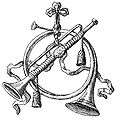Clarion (instrument)
Clarion is a common name for a trumpet in the Middle Ages and the Renaissance. It also is used as a name for a 4' organ reed stop.[1] There is wide confusion over whether clarion invariably refers to a type of trumpet or simply the upper register of the standard trumpet.
Etymology
"Clarion" derives from three Latin words: the noun clario (trumpet), the adjective clarus (bright or clear), and the verb claro (to make clear). Throughout Europe, an eclectic set of variations on clarion came into use. The meaning of these variations was not standard. It is not clear whether they are meant to refer to an actual instrument or simply the high register of the trumpet.
In France, the usage evolved into words like "clairin", "clarin", "clerain", "clerin", "clairon", "claroncel", and "claronchiel". Clairon become the most commonly used version. English variants were "claro", "clario", "clarone", "clarasius", "clarioune", "claryon" and "clarion". In Spain, the terminology became "clarín" and "clarón". Italians used "chiarina", "chiarino", and "claretto", and by 1600, they began to use "clarino" or "chlarino", which became a standard, albeit widely misunderstood, term. In Germany, the usage was "clareta", and by the middle of the 16th century, "clarin".[2]
Usage
The various iterations of "clarion" occur alongside the idiomatic usage of "trumpet" in the literature and historical records of several different countries. The presence of these terms in concert with each other throughout such passages gave rise to a consensus that there must be a clarion trumpet which is distinct in construction from a standard trumpet. In France, historical records include phrases like "à son de trompes et de clarons", for instance. In his French dictionary, Jean Nicot wrote that the clarion is used among the Moors and the Portuguese (who adopted the Moors' custom). Nicot defines the clarion as a treble instrument, which is paired with trumpets playing the tenor and bass. Nicot also specifies that the clarion was used by the Cavalry and Marines.[3]
In The Knight's Tale, Chaucer writes, "Pypes, trompes, nakers, clariounes, that in bataille blowen blody sounes," which adds to the notion that clarions must somehow be distinct from trumpets.[4]
This idea was bolstered by artworks of the time, which show a variety of trumpets in different shapes and sizes. There are even records from trade guilds like the Goldsmith's Company of London which specify that a clarion is 70% lighter than a trumpet. However, there is no precise understanding of what any of these variations meant. The fundamental confusion is over whether or not they refer to an actual instrument or to a style of playing in the high register of the trumpet. Even the Spanish historian Sebastián de Covarrubias confused the meaning in his Tesoro de la lengua castellana o española, writing that the clarin was a "trumpetilla", a tiny trumpet capable of playing in the high register or that the term could simply refer to the high register of the trumpet.[5]
The confusion over the usage of these terms seemed to mainly dissipate in the Baroque era, when "clarino" (plural: "clarini"), and its variants, came to be specifically understood as the practice of playing the natural trumpet in its high register. The principal register of the instrument extends to the seventh pitch of the harmonic series. The clarino register runs from the eighth to the twentieth pitch in the series.[6]
References
- ↑ Randel, Don. The New Harvard Dictionary of Music. Cambridge: Belknap Press of Harvard University Press, 1986. p. 172.
- ↑ Dahlqvist, Reine, and Edward H. Tarr. "Clarino," Grove Music Online, Accessed: November 6, 2011
- ↑ Chamber, Ephraim. Cyclopaedia, p. 232.
- ↑ Tarr, Edward H. The Trumpet. Portland: Amadeus Press, 1988. p. 41.
- ↑ Dahlqvist & Tarr.
- ↑ Randel, p. 171.
Additional reading
- Forsyth, Cecil (1982). Orchestration. Dover Publications Inc. ISBN 0-486-24383-4
| ||||||||||||||||
|
